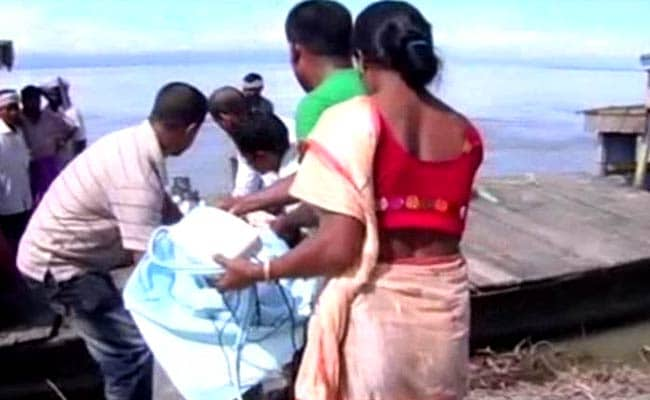The sight of a half-completed bridge.
GUWAHATI:
Wrapped in a blue sheet and placed precariously on a stretcher with his wife nervously watching, Dulendra Panging is lowered into a ferry in Northern Assam. The bike mechanic, in desperate need of treatment for a spinal injury, will spend nearly an hour being delivered to a hospital across the Brahmaputra river in the town of Dibrugarh, about 400 kilometres from the state capital of Guwahati.
Like every year, heavy rains have pounded Assam, impelling massive floods which have affected more than 1.5 million people and forced more than 200,000 people into relief camps.
The mighty Brahmaputra, Assam's main river, swollen with Himalayan snow melt and monsoon rain, has been overflowing in many areas along its course. It has submerged over 2,000 low-lying villages. When the floods arrive, it is always the region of Dhemaji, on the Brahmaputra's northern bank, that is first to be hit.
The town of Dibrugarh, on the other side of the river, is crucial for supplies and hospitals. At this time, the sight of a half-completed bridge that would make the journey easier and so much faster taunts villagers.
 The five-kilometre bridge was sanctioned first in 1985, but formal clearances took another 12 years. Construction began in 2002.
The five-kilometre bridge was sanctioned first in 1985, but formal clearances took another 12 years. Construction began in 2002.
Political parties waffle when asked why it remains a work in progress. The Congress government of Tarun Gogoi has led Assam for 15 years. Its leaders say that the BJP-led government at the Centre over a decade ago didn't send enough money, after which work on the bridge was suspended.
"At the time of the earlier NDA government, there was poor release of funds," said the party's Pawan Singh Ghatowar , a former Congress parliamentarian from Dibrugarh.
Decades of mass deforestation in mountainous Assam have led to soil erosion where sediment is washed downstream from hilly areas. It builds up on the river bed, raising the level of the water far higher than normal.
Every year, the floods are tailgated by diseases including diarrhea. In the tribal villages of remote Dhemaji, doctors struggle to access patients and offer even basic health care.
"The biggest problem is of health, hygiene and communication," said Dr Arun Kumar Dhingia, a government doctor.
The bridge, two-thirds ready, towers above the landscape with unfulfilled promise, a potential solution distorted by a lack of political will.
Like every year, heavy rains have pounded Assam, impelling massive floods which have affected more than 1.5 million people and forced more than 200,000 people into relief camps.
The mighty Brahmaputra, Assam's main river, swollen with Himalayan snow melt and monsoon rain, has been overflowing in many areas along its course. It has submerged over 2,000 low-lying villages. When the floods arrive, it is always the region of Dhemaji, on the Brahmaputra's northern bank, that is first to be hit.
The town of Dibrugarh, on the other side of the river, is crucial for supplies and hospitals. At this time, the sight of a half-completed bridge that would make the journey easier and so much faster taunts villagers.

A man being taken to a hospital across the river
Political parties waffle when asked why it remains a work in progress. The Congress government of Tarun Gogoi has led Assam for 15 years. Its leaders say that the BJP-led government at the Centre over a decade ago didn't send enough money, after which work on the bridge was suspended.
"At the time of the earlier NDA government, there was poor release of funds," said the party's Pawan Singh Ghatowar , a former Congress parliamentarian from Dibrugarh.
Decades of mass deforestation in mountainous Assam have led to soil erosion where sediment is washed downstream from hilly areas. It builds up on the river bed, raising the level of the water far higher than normal.
Every year, the floods are tailgated by diseases including diarrhea. In the tribal villages of remote Dhemaji, doctors struggle to access patients and offer even basic health care.
"The biggest problem is of health, hygiene and communication," said Dr Arun Kumar Dhingia, a government doctor.
The bridge, two-thirds ready, towers above the landscape with unfulfilled promise, a potential solution distorted by a lack of political will.
Track Latest News Live on NDTV.com and get news updates from India and around the world

